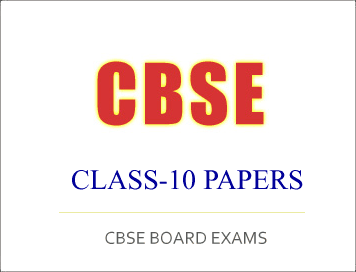CBSE Class-10 Exam 2017 : Marking Scheme, French
Disclaimer: This website is NOT associated with CBSE, for official website of CBSE visit - www.cbse.gov.in
CBSE Class-10 Exam 2017 : Marking Scheme
Question Paper French
CBSE Class-10 Exam 2017 : French
All India Secondary School Examination
March 2017
Marking Scheme - French 20
General Instructions:
(i) The Marking scheme carries only suggested value points for the answers. These are only Guidelines and do not constitute the complete answer. The students can have their own expression and if the expression is correct, the marks may be awarded accordingly.
(ii) As per orders of the Hon'ble Supreme Court, the candidates would now be permitted to obtain a photocopy of the Answer Book on request on payment of the prescribed fee. All Examiners/ Head Examiners are once again reminded that they must ensure that evaluation is carried out strictly as per value points for each answer as given in the Marking Scheme.
(iii) All the Head Examiners/Examiners are instructed that while evaluating the answer scripts, if the answer is found to be totally incorrect, the 'x' should be marked on the incorrect answer and awarded '0' Marks.
(iv) The Marking Scheme has been prepared keeping the above in mind.
(v) In the marking scheme, a slash (/) indicates alternative answers: any one such answer should be accepted.
(vi) Brackets ( ) indicate optional information; the mark is awarded whether the information in brackets is included or not.
(vii) If a student writes an answer which is not given in the marking scheme but which is equally acceptable, full marks should be awarded. If an option does not figure in the MCQ, but is grammatically correct, it may be awarded marks.
(viii) Students should not be penalized if they do not follow the order of the section / question while answering. For 'fill in the blanks', full sentences are not a requirement.
(ix) Some of the questions may relate to higher order thinking ability (HOTS). These questions are indicated separately. They are to be evaluated carefully and the student’s understanding/analytical ability may be judged.
(x) Every section carries general instructions at the beginning of the section. However, for section C some exercises may have specific marking instructions.
(xi) Any recurring error should be penalised only once.
(xii) A flawless answer script may be awarded full marks.
Question Paper Code 20
SECTION-A (10 Marks)
General Instructions
- No marks to be deducted for omission of articles, incorrect articles, minor spelling errors, accents, punctuations.
1. Lisez bien le texte et répondez aux questions qui suivent:
L’île de Bali se trouve à 3,2 km à l’est de Java. C’est le détroit de Bali qui fait la
séparation entre Bali et Java.
La chaîne montagneuse du centre de Bali comprend plusieurs pics de plus de 2000 mètres d’altitude. Le plus haut est l’Agung, un volcan actif baptisé la « mère montagne ». La nature volcanique de Bali contribue à son exceptionnelle fertilité et ses hautes chaînes montagneuses provoquent les fortes précipitations favorisant la forte production du secteur agricole. La vaste zone descendant du côté sud des montagnes est consacrée à la
culture du riz. Le fleuve le plus long est la rivière Ayung. Bali n’a pas de voies navigables importantes. L’île est entourée de récifs coralliens*. Les plages du sud sont de sable blanc et celles du nord et de l’est sont de sable noir. Les plages de sable noir entre Pasut et Klatingdukuh
ont été développées pour le tourisme. Trois petites îlessituées au sud-est sont NusaPenida, NusaLembongan et NusaCeningain. Elles sont séparées de Bali par le détroit de Badung. (récifs coralliens : coralreefs)
1.1 Répondez aux questions : 1x2=2
a. Quelle est l’importance des hautes chaînes montagneuses dans l’île de Bali ?
Les hautes chaînes montagneuses provoquent les fortes précipitations favorisant la forte production du secteur agricole.
b. Quelle est la différence entre les plages du sud et les plages du nord ?
Les plages du sud sont de sable blanc et celles du nord et de l’est sont de sable noir. (Les plages de sable noir entre Pasut et Klatingdukuh ont été
développées pour le tourisme)
1.2 Trouvez dans le texte un mot qui veut dire : 1x2=2
a. une céréale très populaire en Inde. riz
b. une masse de terre entourée d’eau. île
½ mark to be given for ‘plag
